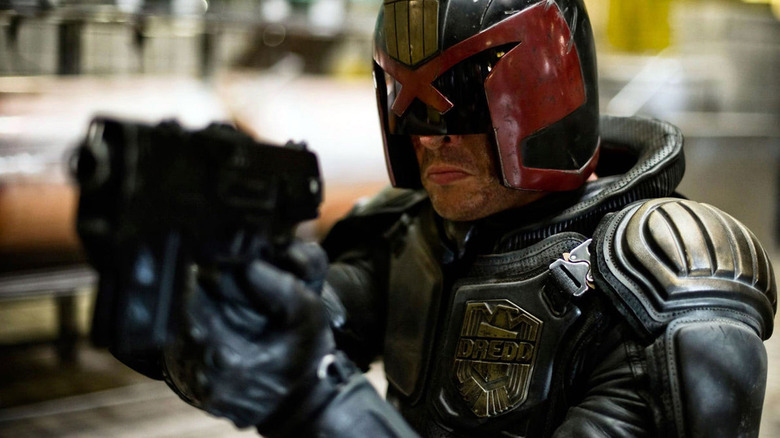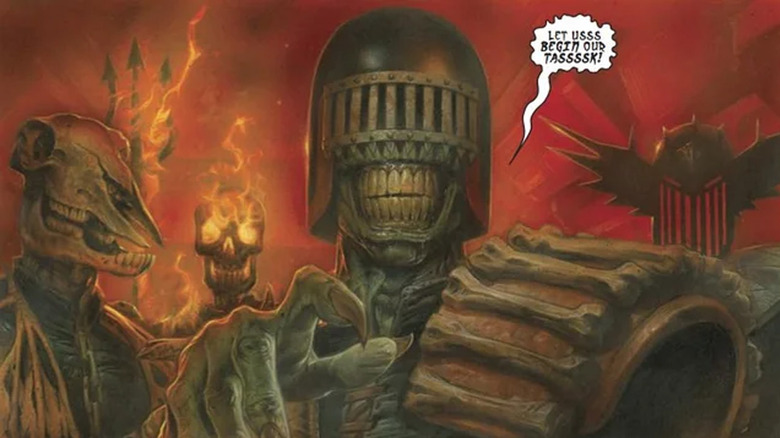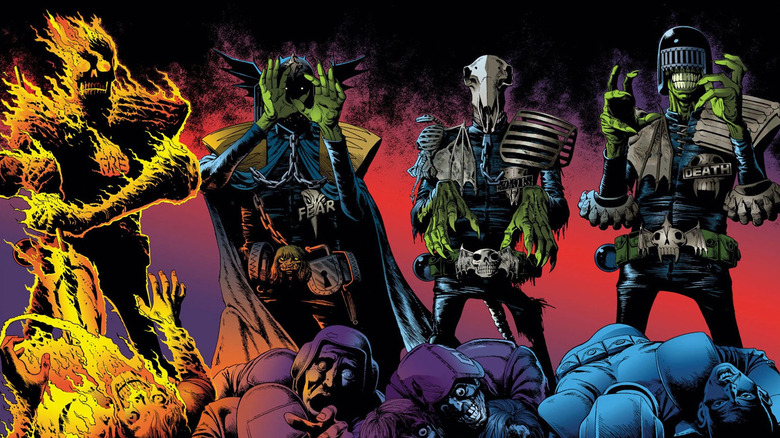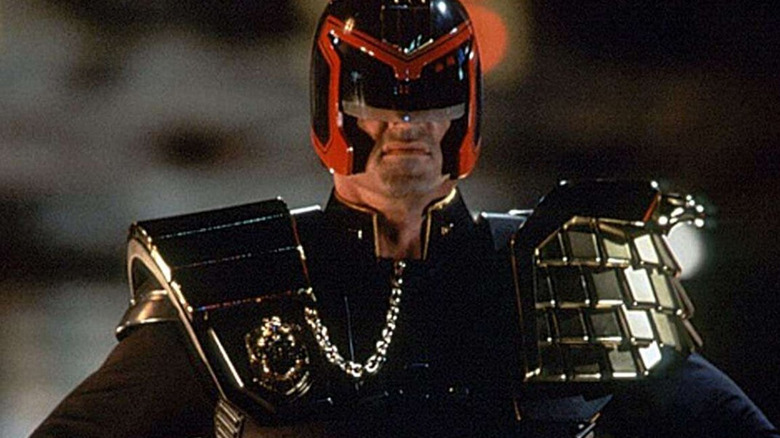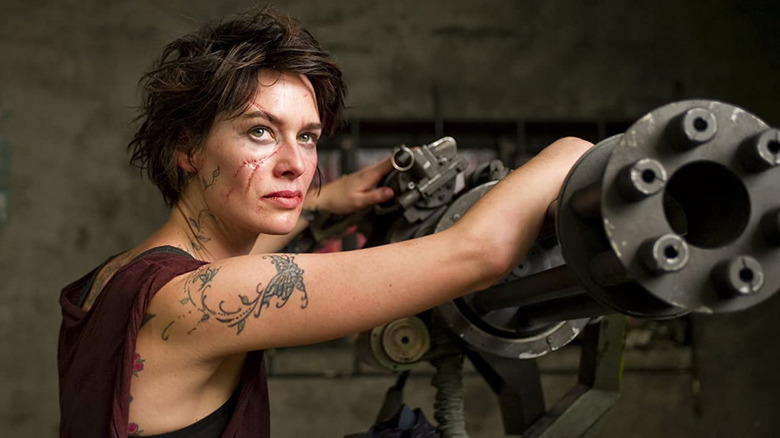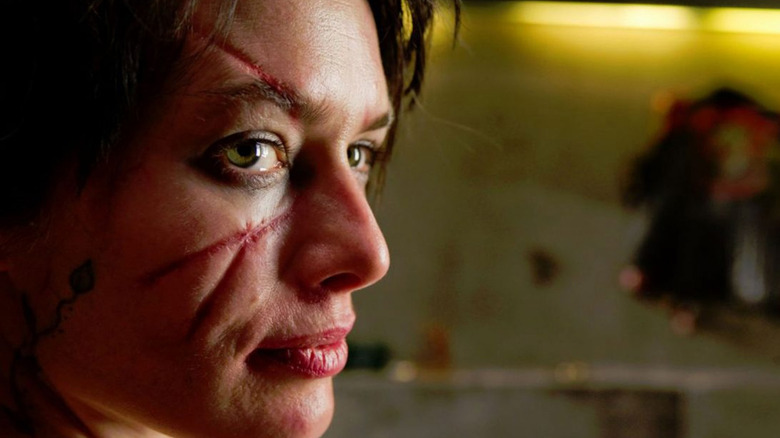Dredd's First Draft Went Fully Apocalyptic With Its Plot
Back in 2012, "Dredd" reinvented a classic British comic book for a modern audience. Starring Karl Urban as the legendary Judge Dredd, the film reimagines the dystopian future of Mega-City One with a deep dive into the violent and brutal world of Peach Trees — a 200-storey slum tower block.
"Dredd" was an instant hit with both newcomers and fans of the comic books, likened to a sci-fi version of Gareth Evans' own tower block-based action thriller "The Raid," which was released just one year earlier. That's high praise, but it's also well-deserved. As a fan of the comic books, I grew up on "2000 AD," and "Dredd" was the big screen adaptation I'd been waiting for.
Of course, we had seen the iconic judge in theaters before with the 1995 movie "Judge Dredd," starring Sylvester Stallone. There was a lot the movie got right – the ABC warrior and Mean Machine still feel like an absolute triumph. But we didn't really get the Judge Dredd we know and love ... until "Dredd."
Karl Urban was a truly inspired pick to don the iconic helmet, and the gritty urban setting gave us an ultraviolent look that may have differed from the comic books but reflected the grim reality of living in Mega-City One. But while it was already shaping up to be one mean comic book adaptation, director Alex Garland revealed that the first planned storyline was downright apocalyptic:
"In pass one, there were these dark judges that were supernatural riffs on Judge Dredd."
That's right – the original first draft of "Dredd" brought the Dark Judges to the big screen.
First Draft: The Dark Judges
The Dark Judges have existed in "2000 AD" since 1980, with the first appearance of Judge Death in "2000 AD" #149. They're essentially the four horsemen of the apocalypse with a sci-fi twist: Judge Death, Judge Fire, Judge Fear, and Judge Mortis. And according to Garland, "Dredd" was originally going to focus on them:
"They were a supernatural force that figured out that crime was only carried out by the living. Therefore, if you follow it through, you get rid of the living and you have no crime. So, they try to embark on a total genocide, which Judge Dredd says no to."
Honestly, that sounds rather epic, even if it is a far cry from the "Dredd" that ended up on our screens. It also sounds very close to the Dark Judges' comic book origins. Hailing from an alternate dimension known as Deadworld, the Dark Judges were originally human — albeit a twisted take on the judges we know and love. But a dark pact caused them to gain supernatural powers, and thus the Dark Judges were born.
If Judge Dredd is a social commentary on authoritarianism, the Dark Judges ramp it up to 11. Essentially, they see life itself as a crime and embark on a genocide, wiping out all life in their dimension. It's quite a crusade, but it leaves them alone in the universe with nothing to do but focus on their own insecurities ... that is, until some dimension-hopping travellers from Mega-City One find themselves in Deadworld.
Slaughtering these travellers and requisitioning their dimension-jumping tech, the Dark Judges head to Mega-City One — a bastion of life and crime — and they become obsessed with administering their sick brand of justice upon its citizens. But who exactly are the Dark Judges and why didn't they end up on the big screen?
Who are the Dark Judges?
Judge Death is the most recognizable, wearing a helmet similar to those worn by Judge Dredd. However, his visor has been modified to resemble a portcullis. Think of a gothic twist on a standard Judge and you're not far off. His shoulder pads sport a pterodactyl skull and assortment of bones with his leather jacket done up using stitches instead of a zipper. Judge Death embodies death itself and most often kills his victims by reaching into their chests using his incorporeal form and squeezing their hearts until they burst. Grim.
Judge Fire is immersed in flame with a human skull for a head (think Ghost Rider meets Judge Dredd). Originally named Judge Fuego, he earned the name "Judge Fire" while still human, when he burned down an entire school for breaching noise regulations during playtime.
Judge Fear looks almost medieval by comparison, with a black winged helmet and massive bear traps in place of his shoulder pads. His helmet opens to reveal his victim's worst fears, as he literally terrifies them to death. And finally, Judge Mortis has a sheep's skull in place of his head and is in a perpetual state of decomposition — his touch causing his victims to rapidly decay.
Unfortunately, the studio wasn't sold on these supernatural elements, despite the popularity of Judge Death and his kin among "2000 AD" fans. Judge Dredd creator John Wagner explained what happened:
"The first script that Alex Garland did was a Judge Death script but Fox, who they were dealing with at the time, turned it down. They wanted more nuts and bolts before they went into the [metaphysical]."
The rest is history, as the version of "Dredd" that made it to screen focused on a much more down-to-earth story.
Second Draft: A Dredd origin story?
Heading back to the drawing board, Alex Garland decided to try going back to Judge Dredd's roots, penning a second draft which riffed on the origins of Mega-City One and its Judges. "The second one was really about the city and the origins of the city and the judge system," he said.
Sound familiar? That's essentially what Sylvester Stallone's "Judge Dredd" was all about.
Set in the 2080s, "Judge Dredd" follows the iconic character, dispensing justice as judge, jury and executioner. We got to see Sylvester Stallone shout "I am the law!" as well as Armand Assante as the mysterious Rico — a character any "2000 AD" reader will know is Dredd's brother. Watching this as a kid, I remember the film's visual style being almost exactly as I had pictured a real-life Mega-City One. Unfortunately, even then I could smell a faint whiff from Stallone's acting, and the over-the-top conspiracy plot was far too thin.
However, there were some great moments. Watching Max von Sydow take the long walk out into the Cursed Earth as a retiring Chief Justice was simply incredible, and the practical effects used to bring the ABC warrior and mean Machine to life were out of this world. When it comes to Garland's script however, it looks as though Fox weren't keen to retread these classic origins.
"And then in the third one, that was when Ma-Ma arrived."
Third Draft: Ma-Ma
After passing up an apocalyptic future and an origin story, the studio settled on Ma-Ma. Played by Lena Headey, the psychotic, vicious villain is the perfect foil for Karl Urban's Judge Dredd — a sinister gang leader who would gouge your eyes out as soon as look at you.
"I just liked the idea that this guy was fighting a woman," said Garland. "He's so male and there's just too much testosterone, arguably, and you want to subvert that."
The idea was to give Dredd something other than a gang of gun-loving criminals to go up against. Ma-Ma is something else entirely. Real name Madeleine Madrigal, Ma-Ma is a former prostitute who managed to fight her way to the top of the food chain. Now, her gang controls Peach Trees, and with two Judges daring to infringe on her territory, there's only one thing left to do. She announces:
"Peach Trees, this is Ma-Ma. Somewhere in this block are two Judges. I want 'em dead. Until I get what I want the block is locked down. All Clan, every level, hunt the Judges down. Everyone else, clear the corridors and stay the f*** outta our way until the shooting stops. If I hear of anyone helping the Judges, I will kill them and the next generation of their families. As for the Judges ... sit tight or run. It makes no difference, you're mine."
Putting a strong, powerful woman in charge of the entire block is quite the power move, and Garland explains that it was all about subverting expectations:
"Honestly, however it looks, the film is trying to be subconsciously subversive the whole time in one way or another, and Ma-Ma and Lena Headey was a big part of that."
A brand-new comic book villain
Unlike Garland's previous ideas, Ma-Ma was not straight from the comic books – instead, she's an original creation just for the film. But while her grimy, gritty style is more at home in "Dredd," it looks as though his original idea was far more in line with a satirical, 2000AD style villain.
"The first time I imagined her it was Brendan Gleeson in drag," he laughed. "That was the picture I had in my head. It was very different from Lena Headey. Then Lena came in and did a reading and it was just a phenomenally good reading."
Obviously I'm sad that we didn't get to see Brendan Gleeson in drag. But Headey's ultra-violent, yet calmly sinister Ma-Ma proved to be the perfect "Dredd" villain. Sure, Dredd goes toe-to-toe with plenty of gun-toting psychopaths and even the occasional corrupt Judge as he fights his way to the top of Peach Trees. There's plenty of brawn for him to lock horns with. But the true test of his legendary resolve is going up against an opponent who's as calculating as she is brutal. Garland recalled:
"She took an approach for the character where there were lines that could be read as being psychotically angry and smashing stuff up or getting in someone's face and smashing their head through a table and really going to town, and she made it very calm and controlled, and that made her scarier and more malevolent. Honestly, within two minutes of her opening her mouth or less, maybe even thirty seconds, I was on the edge of my seat thinking, 'Oh my God. We found her. This is perfect. Don't do anything wrong.' It was great."
What we ended up with was a brand-new "Judge Dredd" villain who brought a certain order to her chaos ... and left the entire Peach Trees block vying for her affection. Even in the film's climactic fight, she almost outsmarts Dredd. Almost.
Better luck next time, Ma-Ma. He is the law, after all.
